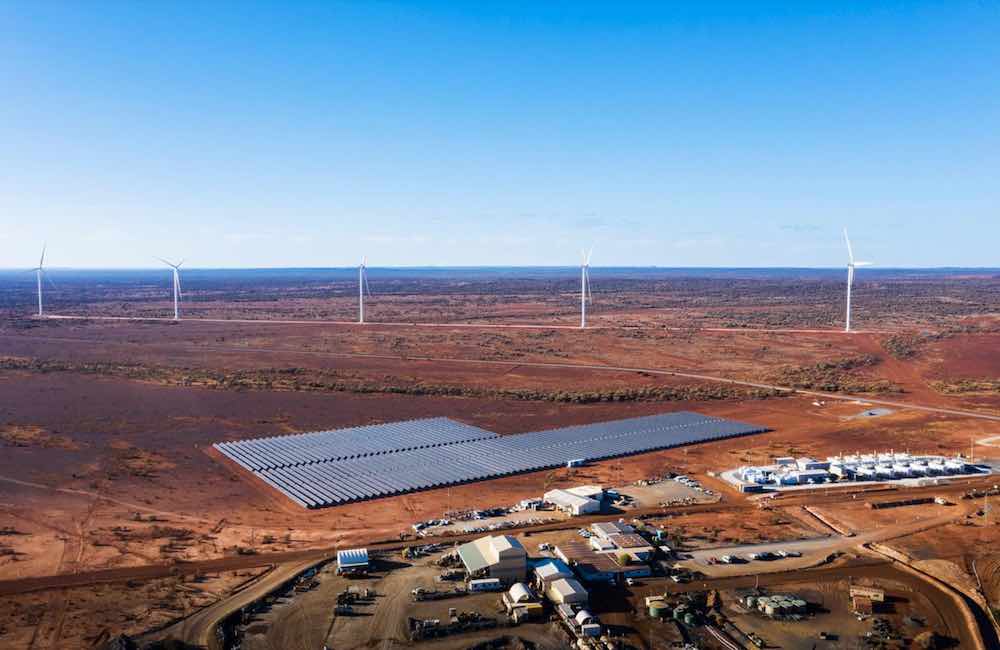

Image: EDL Energy
Australia’s largest hybrid renewable microgrid – the 56MW solar, wind and battery project developed by EDL at the Agnew gold mine in Western Australia – has had its official launch, some six months after its completion in the midst of the Covid-19 pandemic.
The ground-breaking microgrid combines five wind turbines (18MW), a 4MW solar farm and a 13MW/4MWh battery energy storage system, to provide an average of between 50-60% of renewables for the mine in WA’s northern Goldfields region.
The renewable components of the off-grid system are backed up by a 21MW gas/diesel engine power plant and managed by an advanced microgrid control system that has, in favourable conditions, achieved up to 85% renewables at the mine.
The ARENA-backed microgrid project was developed and is now operated by EDL under a 10-year agreement to supply power to the Agnew gold mine, which is owned by the company Gold Fields.
The project started by adding the solar to the gas and diesel plant in 2019, and then installed the wind turbines in early 2020, making it Australia’s first mining sector project to use wind power as part of a large hybrid renewable microgrid.
A similar non-resources project is currently being developed to meet just under half of the energy needs of the Western Australia coastal town of Esperance, using a mix of 4MW of solar, two 4.5MW wind turbines, a 5.5MW/1.9MWh lithium-ion battery system and gas generators.
The WA resources sector has served as an important test-bed for innovative renewable energy and battery based microgrid power solutions, including a hybrid solar and battery system being put together by Juwi Renewables for the Gruyere Gold Mine, which Goldfields also owns alongside Gold Road Resources.
Goldfields vice president Australasia, Stuart Mathews, said on Thursday that the Agnew project was a testament to what could be achieved by taking courageous decisions and demonstrating true leadership.
“This is important to all of our stakeholders, including our employees, who want to see tangible outcomes in relation to our environmental, social and governance priorities and sustainability vision,” Mathews said.
“With demonstrated success in construction and now operation, this project has provided a framework to take innovative energy solutions further across Gold Fields’ mine sites both in Australia and around the world.”
EDL CEO James Harman said the Agnew microgrid had showcased engineering excellence at every stage – from its inception, to its innovative integration of five energy technologies, to its navigation through a bushfires and a global pandemic.
“Credit must go to Gold Fields for its vision and belief that we would successfully deliver this complex project; and credit must go also to the entire project team, including EDL and all our contractors, who worked tirelessly to safely deliver the Agnew Hybrid Renewable Project on time and on budget.
“Since we completed the microgrid in May 2020, and pulled the switch, it has been powering Gold Fields’ Agnew Gold Mine with clean, reliable renewable energy,” Harman added.
“EDL’s hybrid renewable journey has not stopped with this landmark project. As the energy transition continues at pace, our ultimate goal is 100% renewables, and we look forward to continuing our work to make this a reality.”
Earlier this year, the CEOs of five major mining companies – including Gold Fields – pledged to shift their operations to renewable energy, and to help accelerate the broader decarbonisation of the industry, as part of an unprecedented collective agreement.
As RenewEconomy sister site One Step Off The Grid reported, South32, OZ Minerals, IGO, Gold Fields Australia and Barminco co-signed a statement of intent committing to the electrification of their mine sites, paving the way for the phase-out of costly and heavy-polluting diesel generation.
The pledge was made in conjunction with the establishment of the Electric Mine Consortium, founded by a group of 14 companies in response to climate change and in a bid to harness the economic and social benefits of clean energy, large-scale storage and battery electric vehicles.
NSW-based company unveils its proprietary microemulsion flow battery technology for the first time, promising a…
BNEF says Australia is on the cusp of a big battery boom that could deliver…
Solar households may feel aggrieved about receiving not much for rooftop PV fed into the…
A solar farm and big battery proposed for development north of Geelong has been fast-tracked…
Activist shareholder forces another global energy giant to return money to investors and double down…
Peter Dutton says he will lower the cost of gas. But will that translate into…